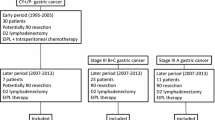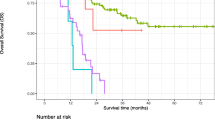Abstract
Background
A positive cytology of peritoneal lavage fluid (CY1) is a poor prognostic factor in patients with gastric cancer (GC). We have recently reported that CY1 often changes to negative (CY0) following combination chemotherapy including intraperitoneal (IP) paclitaxel (PTX), which results in marked prolongation of survival in GC patients with peritoneal dissemination (P1).
Methods
A total of 95 P1 GC patients who received combination chemotherapy with S-1 and intravenous and IP PTX were enrolled. Peritoneal lavage fluid was periodically examined cytologically at the start of every cycle of chemotherapy, and the impact of CY status on patient outcome was retrospectively evaluated.
Results
Seventy-three (76.8 %) of 95 patients were diagnosed as CY1 before initial treatment. Median survival time (MST) of the CY1 group was significantly shorter than that of the CY0 group (19.1 vs. 32.5 months, P = 0.033). Cytological status changed from CY1 to CY0 in 68 (93.2 %) of 73 CY1 patients during the whole treatment period and MST of patients who showed a negative change was significantly longer than that of the unchanged group (20.0 vs. 13.0 months, P = 0.0017). In 64 patients who achieved CY0 by IP PTX regimen, the median time to achieve CY0 was 1.4 months, and patients who achieved a negative change within 1 month showed a particularly good outcome (MST = 26.1 months).
Conclusions
Periodic cytological examination of peritoneal lavage fluid is clinically useful to evaluate the efficacy of treatment as well as to predict the outcome of patients with P1 GC.




Similar content being viewed by others
References
Brigand C, Arvieux C, Gilly FN, Glehen O. Treatment of peritoneal carcinomatosis in gastric cancers. Dig Dis. 2004;22(4):366-73.
Isobe Y, Nashimoto A, Akazawa K, et al. Gastric cancer treatment in Japan: 2008 annual report of the JGCA nationwide registry. Gastric Cancer. 2011;14(4):301-16.
Matharu G, Tucker O, Alderson D. Systematic review of intraperitoneal chemotherapy for gastric cancer. Br J Surg. 2011;98(9):1225-35.
Yonemura Y, Elnemr A, Endou Y, et al. Effects of neoadjuvant intraperitoneal/systemic chemotherapy (bidirectional chemotherapy) for the treatment of patients with peritoneal metastasis from gastric cancer. Int J Surg Oncol. 2012;2012:148420.
Coccolini F, Cotte E, Glehen O, et al. Intraperitoneal chemotherapy in advanced gastric cancer. Meta-analysis of randomized trials. Eur J Surg Oncol. 2014;40(1):12-26.
Kitayama J. Intraperitoneal chemotherapy against peritoneal carcinomatosis: Current status and future perspective. Surg Oncol. 27 2014;23(2):99–106.
Mezhir JJ, Shah MA, Jacks LM, Brennan MF, Coit DG, Strong VE. Positive peritoneal cytology in patients with gastric cancer: natural history and outcome of 291 patients. Ann Surg Oncol. 2010;17(12):3173-3180.
La Torre M, Ferri M, Giovagnoli MR, et al. Peritoneal wash cytology in gastric carcinoma. Prognostic significance and therapeutic consequences. Eur J Surg Oncol. 2010;36(10):982-986.
Lee SD, Ryu KW, Eom BW, Lee JH, Kook MC, Kim YW. Prognostic significance of peritoneal washing cytology in patients with gastric cancer. Br J Surg. 2012;99(3):397-403.
Sobin LG. TNM classification of malignant tumours, 7th edn. New York: Wiley; 2009.
Association JGC. Japanese classification of gastric carcinoma, 3rd English edn. Gastric Cancer. 2011;14(2):101-12.
Yonemura Y, Bandou E, Sawa T, et al. Neoadjuvant treatment of gastric cancer with peritoneal dissemination. Eur J Surg Oncol. 2006;32(6):661-5.
Fushida S, Kinoshita J, Yagi Y, et al. Dual anti-cancer effects of weekly intraperitoneal docetaxel in treatment of advanced gastric cancer patients with peritoneal carcinomatosis: a feasibility and pharmacokinetic study. Oncol Rep. 2008;19(5):1305-10.
Yonemura Y, Endou Y, Shinbo M, et al. Safety and efficacy of bidirectional chemotherapy for treatment of patients with peritoneal dissemination from gastric cancer: Selection for cytoreductive surgery. J Surg Oncol. 2009;100(4):311-6.
Ishigami H, Kitayama J, Kaisaki S, et al. Phase II study of weekly intravenous and intraperitoneal paclitaxel combined with S-1 for advanced gastric cancer with peritoneal metastasis. Ann Oncol. 2010;21(1):67-70.
Fujiwara Y, Takiguchi S, Nakajima K, et al. Neoadjuvant intraperitoneal and systemic chemotherapy for gastric cancer patients with peritoneal dissemination. Ann Surg Oncol. 2011;18(13):3726-31.
Fujiwara Y, Takiguchi S, Nakajima K, et al. Intraperitoneal docetaxel combined with S-1 for advanced gastric cancer with peritoneal dissemination. J Surg Oncol. 2012;105(1):38-42.
Yamaguchi H, Kitayama J, Ishigami H, Emoto S, Yamashita H, Watanabe T. A phase 2 trial of intravenous and intraperitoneal paclitaxel combined with S-1 for treatment of gastric cancer with macroscopic peritoneal metastasis. Cancer. 2013;119(18):3354-8.
Lorenzen S, Panzram B, Rosenberg R, et al. Prognostic significance of free peritoneal tumor cells in the peritoneal cavity before and after neoadjuvant chemotherapy in patients with gastric carcinoma undergoing potentially curative resection. Ann Surg Oncol. 2010;17(10):2733-9.
Japanese Gastric Cancer Association: Japanese Classification of Gastric Carcinoma—2nd English Edition. Gastric Cancer 1998;1:10–24.
Ishigami H, Kitayama J, Otani K, et al. Phase I pharmacokinetic study of weekly intravenous and intraperitoneal paclitaxel combined with S-1 for advanced gastric cancer. Oncology. 2009;76(5):311-4.
Emoto S, Ishigami H, Hidemura A, et al. Complications and management of an implanted intraperitoneal access port system for intraperitoneal chemotherapy for gastric cancer with peritoneal metastasis. Jpn J Clin Oncol. 2012;42(11):1013-9.
Kitayama J, Ishigami H, Yamaguchi H, et al. Salvage Gastrectomy After Intravenous and Intraperitoneal Paclitaxel (PTX) Administration with Oral S-1 for Peritoneal Dissemination of Advanced Gastric Cancer with Malignant Ascites. Ann Surg Oncol. 2014;21(2):539-46.
Bang YJ, Kim YW, Yang HK, et al. Adjuvant capecitabine and oxaliplatin for gastric cancer after D2 gastrectomy (CLASSIC): a phase 3 open-label, randomised controlled trial. Lancet. 2012;379(9813):315-21.
Katsuragi K, Yashiro M, Sawada T, Osaka H, Ohira M, Hirakawa K. Prognostic impact of PCR-based identification of isolated tumour cells in the peritoneal lavage fluid of gastric cancer patients who underwent a curative R0 resection. Br J Cancer. 2007;97(4):550-6.
Cotte E, Peyrat P, Piaton E, et al. Lack of prognostic significance of conventional peritoneal cytology in colorectal and gastric cancers: results of EVOCAPE 2 multicentre prospective study. Eur J Surg Oncol. 2013;39(7):707-14.
Leake PA, Cardoso R, Seevaratnam R, et al. A systematic review of the accuracy and utility of peritoneal cytology in patients with gastric cancer. Gastric Cancer. 2012;15(Suppl 1):S27-37.
Acknowledgment
This work was funded by the Ministry of Education, Culture, Sports, Science and Technology of Japan and the Ministry of Health, Labor and Welfare of Japan, and by a grant-in-aid of the Public Trust Surgery Research Fund, Tokyo, Japan. We thank Ms. I. Nieda for her clerical work.
Funding
This work was funded by the Ministry of Education, Culture, Sports, Science and Technology of Japan and the Ministry of Health, Labor and Welfare of Japan, and by a grant-in-aid of the Public Trust Surgery Research Fund, Tokyo, Japan.
Disclosures
The authors have no financial disclosure.
Author information
Authors and Affiliations
Corresponding author
Rights and permissions
About this article
Cite this article
Emoto, S., Kitayama, J., Ishigami, H. et al. Clinical Significance of Cytological Status of Peritoneal Lavage Fluid During Intraperitoneal Chemotherapy for Gastric Cancer with Overt Peritoneal Dissemination. Ann Surg Oncol 22, 780–786 (2015). https://doi.org/10.1245/s10434-014-4082-y
Received:
Published:
Issue Date:
DOI: https://doi.org/10.1245/s10434-014-4082-y




